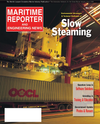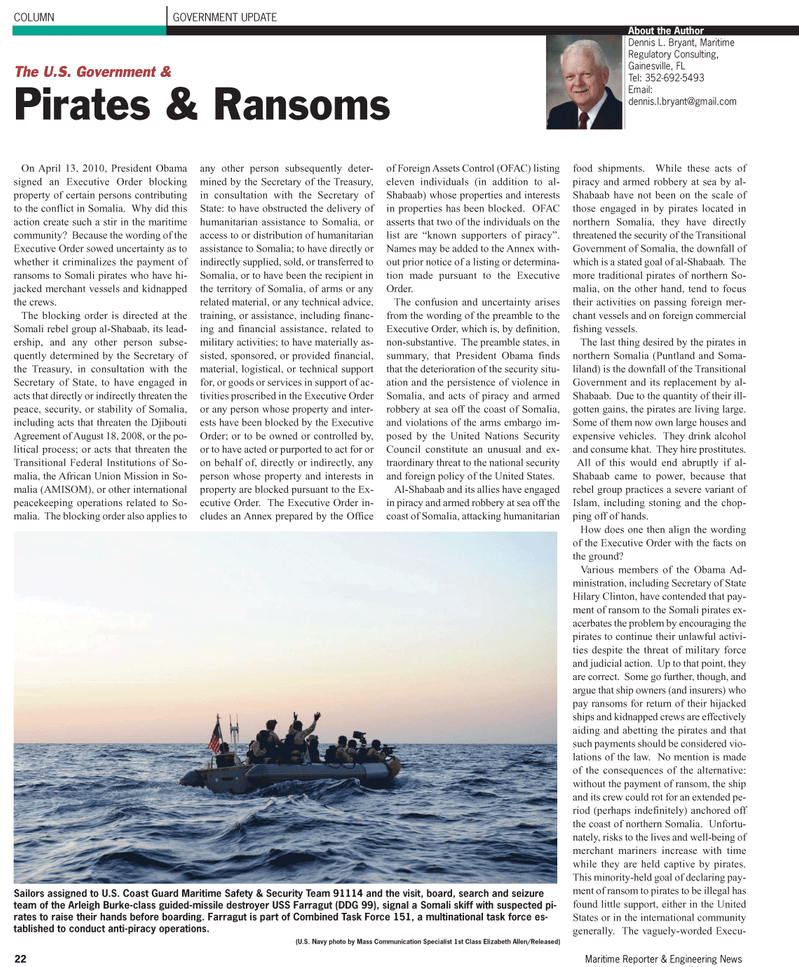
Page 22: of Maritime Reporter Magazine (May 2, 2010)
Read this page in Pdf, Flash or Html5 edition of May 2, 2010 Maritime Reporter Magazine
On April 13, 2010, President Obama signed an Executive Order blocking property of certain persons contributing to the conflict in Somalia. Why did this action create such a stir in the maritime community? Because the wording of the
Executive Order sowed uncertainty as to whether it criminalizes the payment of ransoms to Somali pirates who have hi- jacked merchant vessels and kidnapped the crews.
The blocking order is directed at the
Somali rebel group al-Shabaab, its lead- ership, and any other person subse- quently determined by the Secretary of the Treasury, in consultation with the
Secretary of State, to have engaged in acts that directly or indirectly threaten the peace, security, or stability of Somalia, including acts that threaten the Djibouti
Agreement of August 18, 2008, or the po- litical process; or acts that threaten the
Transitional Federal Institutions of So- malia, the African Union Mission in So- malia (AMISOM), or other international peacekeeping operations related to So- malia. The blocking order also applies to any other person subsequently deter- mined by the Secretary of the Treasury, in consultation with the Secretary of
State: to have obstructed the delivery of humanitarian assistance to Somalia, or access to or distribution of humanitarian assistance to Somalia; to have directly or indirectly supplied, sold, or transferred to
Somalia, or to have been the recipient in the territory of Somalia, of arms or any related material, or any technical advice, training, or assistance, including financ- ing and financial assistance, related to military activities; to have materially as- sisted, sponsored, or provided financial, material, logistical, or technical support for, or goods or services in support of ac- tivities proscribed in the Executive Order or any person whose property and inter- ests have been blocked by the Executive
Order; or to be owned or controlled by, or to have acted or purported to act for or on behalf of, directly or indirectly, any person whose property and interests in property are blocked pursuant to the Ex- ecutive Order. The Executive Order in- cludes an Annex prepared by the Office of Foreign Assets Control (OFAC) listing eleven individuals (in addition to al-
Shabaab) whose properties and interests in properties has been blocked. OFAC asserts that two of the individuals on the list are “known supporters of piracy”.
Names may be added to the Annex with- out prior notice of a listing or determina- tion made pursuant to the Executive
Order.
The confusion and uncertainty arises from the wording of the preamble to the
Executive Order, which is, by definition, non-substantive. The preamble states, in summary, that President Obama finds that the deterioration of the security situ- ation and the persistence of violence in
Somalia, and acts of piracy and armed robbery at sea off the coast of Somalia, and violations of the arms embargo im- posed by the United Nations Security
Council constitute an unusual and ex- traordinary threat to the national security and foreign policy of the United States.
Al-Shabaab and its allies have engaged in piracy and armed robbery at sea off the coast of Somalia, attacking humanitarian food shipments. While these acts of piracy and armed robbery at sea by al-
Shabaab have not been on the scale of those engaged in by pirates located in northern Somalia, they have directly threatened the security of the Transitional
Government of Somalia, the downfall of which is a stated goal of al-Shabaab. The more traditional pirates of northern So- malia, on the other hand, tend to focus their activities on passing foreign mer- chant vessels and on foreign commercial fishing vessels.
The last thing desired by the pirates in northern Somalia (Puntland and Soma- liland) is the downfall of the Transitional
Government and its replacement by al-
Shabaab. Due to the quantity of their ill- gotten gains, the pirates are living large.
Some of them now own large houses and expensive vehicles. They drink alcohol and consume khat. They hire prostitutes.
All of this would end abruptly if al-
Shabaab came to power, because that rebel group practices a severe variant of
Islam, including stoning and the chop- ping off of hands.
How does one then align the wording of the Executive Order with the facts on the ground?
Various members of the Obama Ad- ministration, including Secretary of State
Hilary Clinton, have contended that pay- ment of ransom to the Somali pirates ex- acerbates the problem by encouraging the pirates to continue their unlawful activi- ties despite the threat of military force and judicial action. Up to that point, they are correct. Some go further, though, and argue that ship owners (and insurers) who pay ransoms for return of their hijacked ships and kidnapped crews are effectively aiding and abetting the pirates and that such payments should be considered vio- lations of the law. No mention is made of the consequences of the alternative: without the payment of ransom, the ship and its crew could rot for an extended pe- riod (perhaps indefinitely) anchored off the coast of northern Somalia. Unfortu- nately, risks to the lives and well-being of merchant mariners increase with time while they are held captive by pirates.
This minority-held goal of declaring pay- ment of ransom to pirates to be illegal has found little support, either in the United
States or in the international community generally. The vaguely-worded Execu- 22 Maritime Reporter & Engineering News
COLUMN GOVERNMENT UPDATE
The U.S. Government &
Pirates & Ransoms
About the Author
Dennis L. Bryant, Maritime
Regulatory Consulting,
Gainesville, FL
Tel: 352-692-5493
Email: [email protected]
Sailors assigned to U.S. Coast Guard Maritime Safety & Security Team 91114 and the visit, board, search and seizure team of the Arleigh Burke-class guided-missile destroyer USS Farragut (DDG 99), signal a Somali skiff with suspected pi- rates to raise their hands before boarding. Farragut is part of Combined Task Force 151, a multinational task force es- tablished to conduct anti-piracy operations. (U.S. Navy photo by Mass Communication Specialist 1st Class Elizabeth Allen/Released)

 21
21

 23
23
